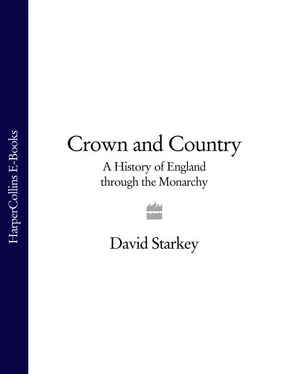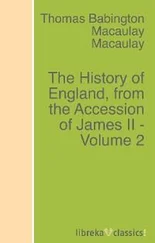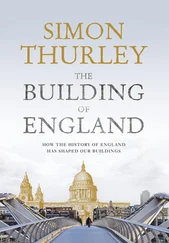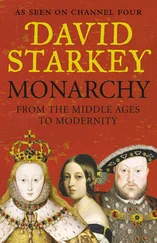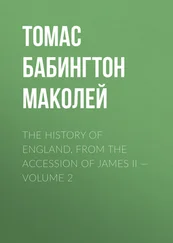Happy chance has preserved the remains of a series of such communities in the Lark valley in Suffolk. They belong to the earliest days of the Anglo-Saxon settlement in Britain and their archaeology confirms Tacitus’s picture in striking detail. The hamlets were widely separated and the houses built of wood. They clustered in three groups, which probably formed the accommodation of three extended families. The larger building in the centre of each group was the hall where the family met, ate and caroused, and where, too, probably the young unmarried men slept. The immigrants depended on simple mixed farming, while their grave-goods suggest a remarkably homogeneous and egalitarian society. Each female grave contained a brooch and only a handful of males were buried with a sword rather than the ubiquitous spear.
For the right to bear arms was as important to the Anglo-Saxons as it was to the framers of the Second Amendment to the American Constitution. And for much the same reason: only a community that could defend itself was free and only someone who could share in that defence had the right to call himself a free man. ‘They transact’, Tacitus noted, ‘no public or private business without being armed.’ The result was a sort of armed democracy. ‘When the whole multitude think proper, they sit down armed … the most complimentary form of assent is to express approbation with their spears.’ This was participatory politics and the polar opposite of the imperial command model of Rome.
Nevertheless, such communities still needed leaders, especially in times of war. But how did they arise? Our earliest sources on the German people, Tacitus and Bede, offer the same answer: they chose or ‘elected’ their kings. And, as the kings were made by the people, they had, as Tacitus again emphasizes, neither ‘unlimited [n]or arbitrary power’ over them. This, then, is the idea of government by consent, in which the leader is chosen by the people, or at least is answerable to them. It was an idea taken by the Anglo-Saxons from their homeland in Germany and transplanted to their new home in England, where it flourished and remains an essential element in the monarchy to the present day.
The contrast with the Rome of Tacitus’s own day – where the emperor ruled and a fawning court adored; where the rich had sold their liberty for luxury and the poor for bread and circuses; where freedom was a memory and liberty an illusion – was all the stronger for being unspoken.
Meanwhile, England, in the immediate aftermath of the Anglo-Saxon conquest, offered special circumstances which encouraged the development of kingship beyond anything the Germans were familiar with back home. Most important was the long, hard-fought nature of the conquest itself. For the Anglo-Saxons’ more-or-less permanent state of war to the death with the British required equally permanent leaders. Moreover, war in a prosperous country like Britain produced booty, which made the war leaders rich. From their new wealth they could reward their followers. This attracted fresh followers and consolidated the loyalty of the old, which made the leaders more powerful still. And so on. Finally, the power and the permanence coalesced into kingship.
The clearest evidence of the change from the relatively egalitarian communities of the early conquest period to a more complex society with greater extremes of rich and poor, of haves and have-nots, comes from the graves known to archaeologists as Fürstengräber (‘princely graves’). They appear by the middle of the sixth century and have a distinctive style. A large mound or barrow was raised over the grave and a rich array and variety of goods placed within it, such as the silver-gilt-hilted sword, silver-studded shield, spear and knife, Kentish glass claw-beaker, Frankish bronze bowl and Frankish silver-gilt-and-garnet-encrusted belt buckle found under the largest barrow of the ‘burial field’ at Finglesham in East Kent.
We shall never know the exact names or ranks of the people buried at Finglesham. But the name Finglesham is itself a clue. Its earliest form, contemporary with the cemetery, is Pengels-ham : ‘the Prince’s manor’; while a couple of miles to the north-west is Eastry, a royal vil of the eventual kingdom of Kent. Almost certainly, therefore, the burials at Finglesham were those of Kentish princes. Were they cadets of an existing royal house? Or were they princes on their way to becoming kings? And what was the source of their wealth? From trade? Or war? Or both?
This halfway world to monarchy is also reflected in the great Anglo-Saxon epic poem Beowulf , which is written much later but appears to preserve folk memories of these earlier times. The poem’s hero, Beowulf, was a local war leader chosen by the people of his district on the mainland. Thanks to his prowess, he eventually became a king, reigned gloriously for fifty winters and was given a magnificent funeral.
The Geat People built a pyre for Beowulf,
stacked and decked it until it stood foursquare,
hung with helmets, heavy war-shields
On a height they kindled the hugest of all
funeral fires; flames wrought havoc in the hot bone-house
burning it to the core … Heaven swallowed the smoke.
Then, after the body and weapons were consumed in the flames,
… the Geat people began to construct
a mound on a headland …
It was their hero’s memorial; what remained from the fire
they housed inside it …
And they buried torques in the barrow, and jewels
and a trove [of golden treasure] …
But Beowulf , impressive though it is, is only literature and scholars were inclined to dismiss its tale of lavish buried treasure as mere embroidery. Then, in 1939, archaeologists began to excavate a mound at Sutton Hoo near Woodbridge in Suffolk. It revealed a burial of epic magnificence. The largest Dark Age ship yet known – ninety feet in length and fourteen feet across at its widest – had been dragged from the River Deben to the top of the hundred-foot-high ridge and laid in an enormous, pre-excavated trench. Then a gabled hut was built amidships and the body, dressed in the deceased’s richest clothes, and surrounded with his weapons, insignia and treasures, was placed within. Finally the trench was filled in and a high mound raised over the ship and its precious cargo.
The mound stood out boldly on the skyline, like an English earth pyramid. Within, the deceased, who had been buried rather than cremated, was sent off on his voyage to the Other World with as rich an array of grave-goods as any pharaoh. The splendour of the contents paralleled or even exceeded the tomb-goods described in the epic. There is gold and garnet jewellery that is unequalled in Europe; weapons for the chase and battlefield; a bronze cauldron for cooking; silver-plate from Byzantium decorated with lavish Classical ornament for feasts; and a harp to accompany the festivities.
But who is buried here? Is he a prince, as at Finglesham? Or was he a king? The fact that the Anglo-Saxons were still illiterate means that the answers to these questions can never be known for certain. Nevertheless, there are several powerful indications, all of which point to Redwald, king of East Anglia and bretwalda or overlord of England. The Merovingian coins in his purse have been redated to c. 625, which corresponds closely to the date (627) given by Bede for Redwald’s death; the location of the burial is a known centre of East Anglian royal power, while the wealth of the grave-goods echoes Bede’s description of Redwald’s great military and political success.
Moreover, the grave-goods seem to be more than just those of a very rich man or even of a prince. Instead, they point to the ‘ceremony’, which Shakespeare’s Henry V identifies as the peculiar attribute of kings. For instance, there is a pattern-welded sword of the finest steel, of the kind we find named and celebrated in the epic poetry of the time; a silvered and gilt helmet based on the design of a late Roman general’s helmet; a decorated whetstone polished from the hardest rock. These surely are regalia – the symbols of a ritualized monarchy – and they include many objects which feature, later in English history, in formal coronation rituals: the sword; the sceptre (for it seems that the whetstone is a sceptre) and the crown (for in later times the Saxon word for crown was cynehelm or helmet of the people).
Читать дальше
